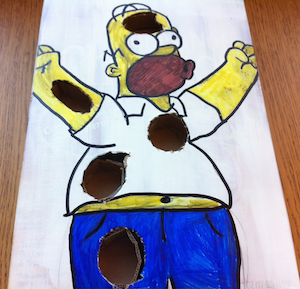Making Our Classrooms More Playful and Fun
 By Josh Burker
By Josh Burker
As an educator, I have thought at length about the role that play and fun serve in the modern classroom. By “classroom” I mean any space where learning happens. The classroom might be in a school with a small or large group of students, a maker space, a library, a community center, a kitchen table, or in a workshop you facilitate.
In Kindergarten, students come into school in the best position to learn because they typically have had time for playful exploration, invention, and unstructured play. A traditional Kindergarten encourages students to learn by creating knowledge through playful hands-on learning.
Typically, there are many different child-friendly materials with which the students can work. Open-ended toys, like wood blocks, serve a prominent role. Often, there is enough space in the classroom for the children’s creations to remain in place, to be worked on over time.
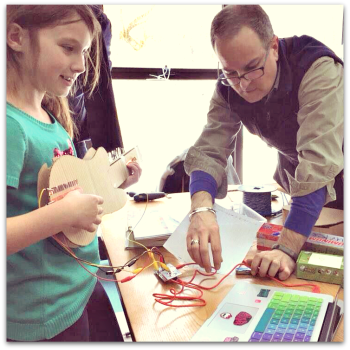
While I am not advocating that we abandon all curriculum and aimlessly play in our classrooms, I do think that there is merit to thoughtfully considering the role play serves in your learning space.
Make time for fun and wonder
How scripted is the time you spend talking to your class? How much of the class time is you, and how much is them? Is there any room for serendipitous discoveries to be made, or are you providing the “ah-ha” moments like a magician hitting her or his cues?
Consider: what about play is so engaging? When you play, do you find yourself in the “zone,” where time elongates? Do you find focus and drive, clarity of vision, and an elasticity in the materials with which you work? Do you have an increased reception to new ideas or perspectives?
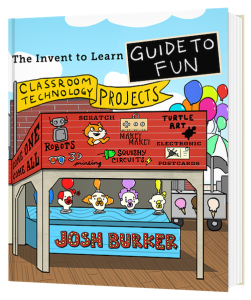
I have led children and adults through successful, playful activities. I have also led people by lecturing, being too theoretical, and explaining everything myself. The more I teach, the more I am convinced that playful activities work better at keeping people’s attention, encouraging them to take risks, teaching them new skills, and collaborating.
8 great arguments for playful making
1. First, there is a capacity for intensity during play. Recall how difficult it is to end recess, to shift children away from the toys and to wash hands for dinner, or to turn on the video game you are playing.
2. People who are at play find focus in the play. They are entertaining themselves through the activity. Play is imagination-driven. Play encourages you to make things up, to try out new ideas, identities, and inventions.
3. In play rules are not externally enforced. That is not to say there are no rules when children are playing, but adults seldom impose the rules on the children who are at play. Instead, the players make up the rules governing the play.
4. There is flexibility to materials in play. Children in particular, but often adults, too, (by self-limitation), have a limited palette of materials with which they are typically allowed or able to work. A child denied the use of the power hacksaw may be upset, but will go on to invent her own “play” hacksaw to mimic the adult version. The child overcomes the limitations of her palette of workable materials by using her imagination.
5. The ability for the maker to build using simple materials lowers the barrier to entry. Cardboard becomes a versatile material for the maker, young and old, because of the facility with which it is cut and worked into different shapes. Cardboard’s familiarity and approachability also sparks a playful approach to using the material. The cardboard can be easily cut with a blade or even scissors in a crunch. It also can be painted or colored with a pen or a crayon. The material easily conforms to the maker’s imagination. Additionally, cardboard boxes can be found in virtually every dumpster, so the act of playful invention become a sustainable, transformative act.
6. Play creates collaborative possibilities. During play, an “expert” is often identified by the players. This player might be particularly good at building bridges with wooden blocks, at leveling the build plate on the 3D printer, or at drawing a good circle.
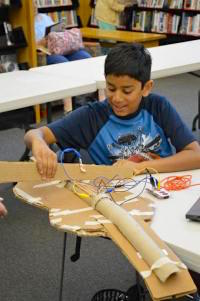
8. Playing in a group allows you to accomplish more. The hurdle to build really large objects is lowered with an extra set of hands to help you hold the material. Play can create an inclusive, educational environment which produces more experts through the players’ “work.”
Play is good for children and adults alike. It promotes intensity, flexible thinking and acting, and collaboration. We should aspire to bring more play into our learning spaces, whether they are in schools, libraries, maker spaces, or our own homes.
Case study: MaKey MaKey Music
In June, 2014, I was selected as the Westport Library’s Maker-In-Residence. I spent 20 hours at the library over the course of the month helping children and adults construct cardboard, wire, aluminum foil, and copper tape musical instruments, which we connected to computers with MaKey MaKeys and programmed in Scratch.
I joked that my Maker-In-Residency workshop was for people ages 8 to 88. It turns out that the gentleman who built the trumpet and performed at the concluding presentation of our experience together was 88, so he just made the cutoff! This video features many of the MaKey MaKey instruments.
The MaKey MaKey project combined many of the ideas I learned in my technology club and at Constructing Modern Knowledge: a space conducive to collaboration and a project dictated by the learner’s interests produce remarkable results.
An additional element made this project successful: building Scratch MaKey MaKey musical instruments was a perfect intersection of technology and crafting. The people who were initially uncomfortable with the perceived difficulty of the project came to embrace the opportunity when they saw the MaKey MaKey and its circuitry and the chance to produce sounds from an instrument they crafted from upcycled materials.
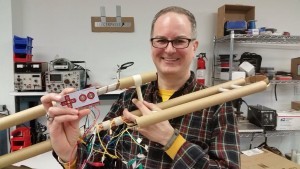
I continue to strive to create spaces in which people can collaborate and work on projects that merge crafting and technology. Recently the independent school at which I work established a Maker Studio where my office is now located.
I hope for it to be a space where teachers from all divisions can work in groups to learn about the engaging tools and technologies we have at our disposal, and then take them to their own classrooms and create projects that encourage intensity and passionate learning.
Download Josh’s complete PDF guide to creating a
MaKey MaKey Scratch version of the Operation game.
_____
Josh Burker (@joshburker) is the author of The Invent To Learn Guide to Fun (2015, CMK Press). He has been teaching for 15 years, currently at a Connecticut independent day school where he works with students and teachers in grades K-5. Josh also helps out at a local library maker space, with home schooled students, and at Scratch Day events, leading maker workshops exploring the intersection of technology and crafting. He holds a Master of Arts in Educational Technology from Pepperdine University and a Bachelors of Arts from Colby College. Geek out at his Blog of Musings.

